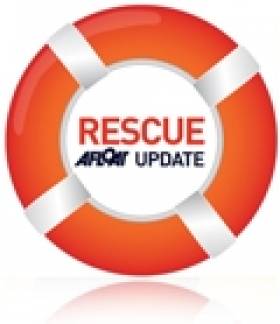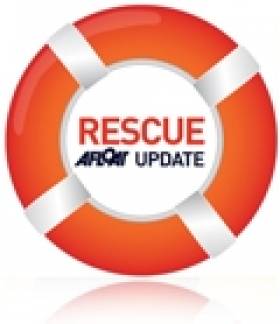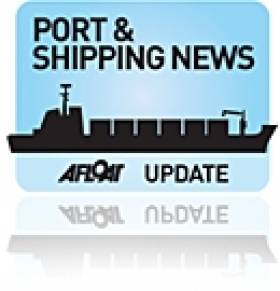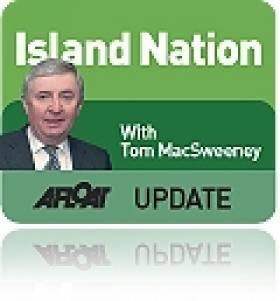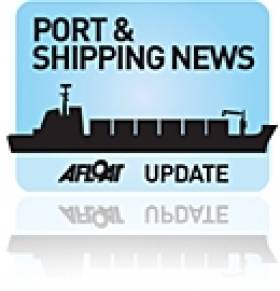Displaying items by tag: maritime
#safetyatsea – Last Thursday (April 16) the Department of Transport published its Maritime Safety Strategy, resulting from the "Sea Change" consultation last year. By chance this coincided exactly with our publication of the ICC's independent analysis of the Marine Casualty Investigation Board reports which form the background to the programme. Norman Kean has now reviewed the latest proposals.
The new Maritime Safety Strategy contains much sensible encouragement, and also 33 proposals for action by the Irish Maritime Administration, under five headings. These include:
• "Intensification of efforts to promote maritime safety awareness through a process of information and communication, and the promotion of more effective communication between key stakeholders"
• "An appropriate regulatory regime for the seaworthiness of vessels and craft and the competency of operators and/or crew"
• "Building on the current enforcement regime."
What does this mean for leisure sailors? Under the Information and Communication heading are some sensible proposals, such as widening the membership of the Marine Safety Working Group, organising an annual maritime safety conference to be open to the public, and addressing children and young people through the education system. This goes some way to recognizing the fact that the people most at risk are not connected to the established organization of sailing clubs and training systems. Lack of awareness is the biggest killer of all.
"Appropriate regulatory regime" translates into the intent to update the Code of Practice for Safe Operation of Recreational Craft, starting in 2016. It is to be hoped that this will be done in a proportionate and well-informed manner, and that the word "should" in respect of things like carriage of equipment does not too often morph into "must". Perish the thought that we might be required by law to submit our boats to annual Government inspection, that we should be compelled on pain of prosecution to report every single arrival and departure to Coast Guards or Harbourmasters, that we might be forced to transmit AIS signals all the time on pain of a fine. All those and many more have been suggested in submissions at the consultation stage of this process. This must not be the thin end of the wedge. Transmitting AIS is undoubtedly a good idea in busy waters, but the accident statistics don't support making it compulsory. We do not need, and we certainly do not want, a Big Brother regime, and the absence of any explicit proposals in that direction is to be welcomed.
Starting in 2017, jet skis and many small speedboats will have to be registered, as defined in the new Registration of Ships Bill, and it appears that the timeline for a new voluntary small craft register will start in 2018. This is far too late. The lack of such a facility for the next three years will leave many owners with no choice but to flag out to other EU states, to avoid facing voyage restrictions and having Irish yachts, at present abroad, put at risk of being impounded for lack of ship's papers.
But it begs the question, what does all that have to do with safety? Might the mention of registration here be a step in the direction of inspection - and ultimately taxation?
A new focus is proposed on more rigorous enforcement of existing legal requirements, with extension of on-the-spot fines for breaches of lifejacket laws quoted. That particular example is common sense and should be applauded by all responsible sailors. The great majority of recreational craft fatalities occur in small open boats and the majority of casualties are not wearing lifejackets when they should be. Conspicuous enforcement would get the attention of those most at risk. Last summer we came across a speedboat grossly overloaded with eleven people aboard; none of the five adults was wearing a lifejacket. If the skipper had been met on the pontoon by a couple of burly Guards who promptly relieved him of several hundred euro, the word might get round and the message might get through. But there must be no mission creep. I was once, at the helm, accosted by a Coast Guard crew who asked me, none too gently, where my lifejacket was, to which I replied that it was safely in its locker, that this vessel was 16 metres in length and perhaps they would care to read their own rules.
Under "Data and Evaluation" it is proposed to commission a baseline study of attitudes to maritime safety. The sailing clubs of Ireland need to be proactive in taking part in that. In respect of cruising sailors, the RNLI is currently doing exactly the same thing, and we must hope that the Maritime Administration takes the results of that study fully into account. Despite the rising trend in callouts to recreational craft, the RNLI continues to be firmly in favour of education over compulsion.
#maritimesafety – The Minister for Transport, Tourism and Sport, Paschal Donohoe, TD, today launched a new Maritime Safety Strategy 2015 – 2019, the theme of which is 'Make Time for Maritime Safety.'
The new Strategy was developed following a consultation with key stakeholders and the general public and includes an analysis of the factors contributing to maritime fatalities in Ireland.
A link to the Maritime Safety Strategy document is HERE.
"My Department's maritime safety remit covers safety on recreational craft, including surfboards, fishing vessels and cargo ships and it is these areas which are covered by the Strategy we are launching today. Although the average annual number of marine incident-related fatalities, at 11, is low, lives continue to be lost on the water, despite regulation, inspections and training. Perhaps not surprisingly, most incidents happen in the fishing and recreational sectors. What is striking, however, is the fact that 99% of maritime fatalities are male, with an average age of 44, and that fatalities in the maritime sector are potentially avoidable.
"There is broad agreement in the sector that to reduce fatalities, the focus needs to be on changing culture and personal behaviour rather than on more regulation. While this Strategy primarily identifies actions that the Department, through the Irish Maritime Administration (IMA) will take, the important roles of individuals, families, friends and sectoral organisations are also highlighted.
"Notwithstanding the efforts of my Department in terms of preventative action, enforcement and emergency response, these efforts cannot on their own improve maritime safety. It is up to each individual who takes to the water to take personal responsibility for their actions and to understand that failure to operate safely puts not just their own life at risk, but the lives of others on board and potentially the lives of emergency and rescue personnel.
"The genesis of this Strategy was the emergence of recurring causal factors in marine casualty investigation reports and recognition of the extent to which maritime fatalities and incidents could be avoided. Among the top 10 factors identified from analysis of the Marine Casualty Investigation Board (MCIB) reports are:
· The need for an enhanced maritime safety culture
· Unsuitable or inadequately maintained safety equipment on board, or lack thereof
· Lack of crew training
· Failure to plan journeys safely, including failure to take sea/weather conditions into account
· Non-wearing of personal flotation device (lifejacket/buoyancy aid)
· Vessel unseaworthy, unstable and/or overloaded
"The 33 actions outlined in the report are grouped under five over-arching strategic objectives; Information and Communication, Search and Rescue Operations, Standards, Enforcement, Data and Evaluation. They are centred on promoting personal responsibility for maritime safety, improving search and rescue, and implementing preventative measures, including a robust inspection and regulatory framework, and an enhanced enforcement regime. They are designed, in a holistic way, to tackle the factors contributing to maritime fatalities and to ultimately reduce in the number of lives lost in the maritime sector.
"This strategy sets out in a very straightforward way, what individuals, families, friends and communities can do to ensure safety when taking to the water. This includes proper planning, operating on a safety first basis, always telling somebody where you are going and when you expect to be back, wearing suitable clothing and always wearing lifejackets and buoyance aids. The Strategy concludes by outlining what my Department can and will do to support a better maritime safety culture. I urge everyone involved in the sector to pay close heed to the Strategy's contents so that together we can reduce, and eventually eliminate, needless fatalities at sea."
New Lusitania Research Changes Data - Merseyside Museum
#lusitania – An exhibition opening at Merseyside Maritime Museum on 27 March called Lusitania: life, loss, legacy will highlight little-known data that changes the commonly used figures of the last 100 years, when referencing the crew and passengers on Lusitania's final voyage.
Omitted from the previous official figures for Lusitania are Fireman Gontes Cloules, Waiter F. Hill and passenger Robert Anderson, taking the figures for people on board from 1,959 to 1,962.
In the days following the sinking, newspapers reported numerous lists of survivors and victims, obtained from various sources. It was March, 1916 when an official booklet known as the 'Cunard Confidential Report' was published, which became the official source. However, it was discovered very early on that this report contained errors, and there were at least two subsequent amendments to this, the last-known published in March 1917.
Gontes Cloules, Waiter F. Hill and passenger Robert Anderson were not included in the official lists of crew and passengers, and are therefore not reflected in the numbers widely used in reference to the tragic sinking of the Lusitania on 7 May, 1915.
Independent historian Peter Kelly has searched records over the last 10 years to bring them back into public consciousness. This and other findings of Peter's, have given us a new level of detail about passengers and crew aboard Lusitania, and will be included in the new exhibition at Merseyside Maritime Museum.
Peter Kelly said: "The figures have always been out there, except that not many of us have looked for them or been able to find them. It's not unusual for records to have been incomplete or incorrect in those times. It was an age before technology, when passenger names were often taken phonetically and misspelt, or maybe people were travelling under a different name.
"I'm not alone in researching this data and trying to tie it down so that everyone who was on-board Lusitania is recognised - whether they lost their lives when the ship went down, or survived this terrible tragedy. We all have our various theories on the names of a number of people who are recorded as having sailed on the ship, and it's a difficult process to work through due to the amount of records and personal accounts out there, some of which provide conflicting information.
"I'm at the point now where the research I've done has led me to believe these new figures are true, accounting for the three extra people that were on-board. The story of the Lusitania has always had some mystery surrounding it, and if more information comes to light about those who were on-board, the figures will be updated again."
Peter's figures will be included in the exhibition as part of an interactive resource, which can also be accessed by the public online from 27 March. The resource is such that any new data and information can be added in the future.
Ellie Moffat said: "This story of the Lusitania is so important here in Liverpool. The ship was the jewel in the city's crown and more than 600 people on her final voyage had connections with the city and wider region. Many people living today are still profoundly affected by the account of a relative who went through the sinking. When Peter came forward with his research, we were thrilled, because we want to share as much, and as complete, information as we can with the city, and with anyone connected to the ship."
General findings:
Total number of people on board:
1962 (total people previously – 1959*)
Everyone on board:
Survived: 771 (survived previously – 761*)
Lost: 1191 (lost previously – 1198*)
Comparison passenger and crew survival rates:
Passengers: 480 survived, 786 lost - 1266 total passengers (total passengers previously 1257*)
Crew: 291 survived, 405 lost - 696 total crew (total crew previously 702*)
* The 'previous official figures' refers to data taken from Cunard's official list of crew published by The Cunard Steam Ship Company in March 1915 and list of passengers lost and saved published by The Cunard Steam Ship Company in March 1916.
Fireman Gontes Cloules
Gontes Cloules was born in Malta in 1891 and lived at 99, Vicnarsa Hania, Malta.
Although the records of the Commonwealth War Graves Commission show that he served on-board the Lusitania as a Fireman in the Engineering Department and was killed when the ship was sunk, he does not appear in the Cunard Steamship Company's list of crew members, either missing or having survived.
However, a Cunard list of crew members who engaged at New York on 30 April 1915 includes the name Cloules Goutes, who signed on as a Fireman at a monthly rate of pay of £4-5s.-0d. Presumably some mistake was made and Goutes was thought to be his surname. The names are too similar for it to be anything else, although there is no Goutes listed amongst the missing either.
The name Gontes Cloules is embossed on the Mercantile Marine Memorial at Tower Hill, London. The register for the memorial does not record any verifying details of his age, family or home.
Waiter, F. Hill
F. Hill (forename not known), was born in Glasgow, Renfrewshire Scotland, in the latter half of the nineteenth century.
He was a professional sailor in the Mercantile Marine and in April 1915, he had engaged to sail to England from New York on the Cunard liner S.S. Cameronia. However, at the end of that month, the Cameronia was taken up from trade by the British Admiralty for war work and on 1 May 1915, all the passengers and cargo and some of the crew were transferred instead, to the Lusitania, then awaiting what became her final transatlantic voyage at Pier 54 in New York harbour. Waiter Hill was one of these crew members and was offered the monthly rate of pay of £4-5s.-0d. (£4.25).
Six days out of New York, when she was off the southern coast of Ireland, the liner was torpedoed and sunk by the German submarine U-20, only hours away from her Liverpool destination, but fortunately, Hill was counted amongst the survivors.
Having been rescued from the sea and landed at Queenstown, he eventually made it to Liverpool where he was officially discharged from the Lusitania's last voyage and paid the balance of wages owing to him. This was in respect of his sea service from 1 May until 8 May 1915; 24 hours after the liner had gone down.
An official list of crew known to have been on board the Lusitania when she was sunk and published by The Cunard Steam Ship Company in March 1915, does not mention Waiter Hill at all, but he does appear in a Particulars of Discharge ledger held in the Public Record Office at Richmond in Surrey.
Robert Anderson
Robert Anderson was born in Ireland in 1875. He was a provision merchant and in 1915, he had been living and trading in New York, N.Y. in the United States of America.
In the spring of 1915, he decided to return home to Ireland - and consequently booked third class passage on the scheduled May sailing of the Lusitania, from New York to Liverpool.
He arrived at the Cunard berth at Pier 54 in New York harbour on the morning of 1 May 1915 - with ticket number 1807 - only to find that the liner's 10.00 a.m. departure had been delayed. This was because she had to wait to embark passengers, crew and cargo from the Anchor Lines vessel the S.S. Cameronia, which the British Admiralty had requisitioned for war service as a troop ship at the end of April.
The Lusitania finally left port just after midday and six days later, on the afternoon of 7 May, she was torpedoed and sunk by the German submarine U-20. At that time, she was only about 250 miles away from her destination and within sight of the coast of southern Ireland.
It was probably the closest that Robert Anderson would get to his homeland as he was killed as a result of this action. As his body was never recovered from the sea and identified afterwards, he has no known grave. He was aged 40 years.
He does not appear in the list of passengers lost and saved which was published by The Cunard Steam Ship Company in March 1916, but he is on a list compiled by the company at a later time and updated as late as February 1917, now held at The Public Record Office at Richmond in Surrey. This record has been found to be a more reliable source.
Creedon's Wild Atlantic Way TV Programme Needs Your Help!
#creedonswildatlanticway – The Wild Atlantic Way, the magnificent West Coast of Ireland - is it the 'land of your heart's desire', as described by William Butler Yeats? RTE's John Creedon is about to find out in his new 3 part series for RTE One, Creedon's Wild Atlantic Way.
"My car is always happiest when it's pointed west," claims John and it's just as well because he's about to travel this epic 2,500 kilometre trip from Kinsale in Cork right up to Donegal's Malin Head. But he needs your help.
"I know there are some real hidden gems out there so I'm putting out the call," said John. "I want people to get in touch and tell me all about them. It could be anything, that little boreen that leads to your secret beach, or the place where you're guaranteed to catch a fish...or a wave!"
But this series is also all about the characters John meets up with. "You might know someone, an uncle, a cousin or even a neighbour", he says "and you've always thought they should be recorded for posterity. They're the people I want to meet, the big personalities that make the west coast such a unique place."
So if you want to contact John with your hidden gem, you can get in touch. Email [email protected]
But the Wild Atlantic Way is more than just a road trip. The sea will be John's highway and he wants to discover just why this beautiful yet savage landscape exerts such a hold on us.
"The West Coast has witnessed Cromwell's tyranny, the famine's devastation and the scourge of emigration," says John. "But it's managed to survive and for many it's become a sanctuary and refuge. It's this reimagining and reinventing that I really want to try and explore."
Landscape, history, characters, poetry, food and a window into the lives of the people who live where the land meets the ocean – all of this will be part of Creedon's Wild Atlantic Way which is due to air on RTE One this Summer.
Why Sea Links Are More Important Than Air Links
#sealinks – In the current debate which has surfaced about the future of Aer Lingus, it is good to hear the realisation in all quarters, from politicians to business, economic and media commentators that Ireland is an 'island nation'. While the importance of air links is being highlighted, those same people could extend their thinking to the maritime links which keep this country alive in a way in which no air linkage can do.
This is emphasised in the leading story in the current edition of my radio programme, THIS ISLAND NATION which you can hear on this website, where I interview the first lady to become President of the Irish Institute of Master Mariners, the professional body for Shipmasters. Sea-going has been a male-dominated profession but Capt. Sinead Reen who lives in Crosshaven, Co.Cork, has done a lot to break that mould. She was also the first woman to qualify as a Deck Officer in Ireland and has served at sea on several types of vessels, including super tankers and cruise ships.
She describes in the interview how she chose a career at sea and, at a time when the Naval Service would not admit women, joined the Merchant Navy: "We are not seen by the general public because we are at sea, carrying the goods, the supplies, the imports, the exports, which this nation needs across the world's seaways. Without ships and seafarers this nation would find it difficult to exist." She discusses life at sea for a woman in a male environment aboardship and speaks of the great opportunities for employment at sea for both women and men. Her election underlines the opportunities of a career at sea for women in what has been a male-dominated profession.
It is an interview worth listening to, as is that about the commemorations planned in the Cork Harbour town of Cobh for the centenary of the sinking of the Lusitania in May.
Hendrik Verway, Chairman of Cobh Tourism, outlines the details of the commemorative plans. Cobh, where survivors of the Lusitania sinking by a German U-boat on May 7, 1915, were landed as well as the bodies of those who were killed in the tragedy, is planning ceremonies on the seafront at Cobh and a sail past by boats on the evening of May 7, with the vessels displaying a single white light to remember those who were killed. Two cruise ships will be in Cobh on the day. One of them, the Cunard's Queen Victoria, will be on a commemorative voyage and on Thursday afternoon, May 7, will sound her ship's whistle at the time at which the torpedo hit the Lusitania, to start a ceremony on the Cobh seafront . A quayside ceremony will start as the whistle sounds and which will conclude at 2.30 p.m., marking the time when the Lusitania sank beneath the waves. 1,198 passengers and crew died. Survivors were landed at Cobh, to where bodies of the dead were also brought and 169 buried. There were 764 survivors. Only 289 bodies were recovered. 169 are buried in the Old Cemetery in Cobh, 149 in three mass graves and 20 in individual plots. Amongst the commemorative events will be a series of lectures and an exhibition of photographs taken in Cobh, then called Queenstown, in the aftermath of the landing there of survivors and bodies by rescue vessels. Many of these photos have not been on public display before and have been digitised for exhibition from original glass plates photographed at the time, through the co-operation of the National Museum. It is also planned to re-enact the funeral of victims to the Old Cemetery in Cobh.
And in another interview on the programme, Paul Bourke of Inland Fisheries Ireland tells me that, for anglers, it has been a good year for the catching of specimen fish.
Fair Sailing...
A New Tall Ship For Ireland? It's Back to The Future
#tallship – The Tall Ships return to Ireland in spectacular style this summer with a major fleet assembly in Belfast from Thursday 2nd to Sunday 5th July for the beginning of the season's Tall Ships Races, organised by Sail Training International. The seagoing programme will have a strong Scandinavian emphasis in 2015, with the route - some of which is racing, other sections at your own speed – starting from Belfast to go on Aalesund in western Norway for 16th to 18th July, thence to Kristiansand (25th to 28th July), which is immediately east of Norway's south point, and then on to conclude at Aalborg in northern Denmark from 1st to 4th August.
But before leaving Northern Ireland with the potentially very spectacular Parade of Sail down Belfast Lough on Sunday July 5th, the celebrations will be mighty. The fleet's visit will be the central part of the Lidl Belfast Titanic Maritime Festival, which will include everything from popular family fun happenings with concerts and fireworks displays – the full works, in other words – right up to high–powered corporate entertainment attractions.
As for the ships, there will be more than enough for any traditional rig and tall ship enthusiast to spend a week drooling over. In all, as many as eighty vessels of all sizes are expected. But more importantly, at least twenty of them will be serious Tall Ships, proper Class A square riggers of at least 40 metres in length, which is double the number which took part in their last visit to Belfast, back in 2009.
That smaller fleet of six years ago seemed decidedly spectacular to most of us at the time. So the vision of a doubling of proper Tall Ship numbers in Belfast Harbour is something we can only begin to imagine. But when you've a fleet which will include Class A ships of the calibre of the new Alexander von Humboldt from Germany, Norway's two beauties Christian Radich and Sorlandet, the much-loved Europa from the Netherlands, George Stage from Denmark, and the extraordinary Shtandart from Russia which is a re-creation of an 18th Century vessel built for Emperor Peter the Great, you're only starting, as that's to name only six vessels – what we'll be seeing will be a truly rare gathering of the crème de la creme.
So although it would be stretching it to think that a small country like Ireland should aspire to having a major full-rigged vessel, we mustn't forget that for 27 glorious years we did have our own much-admired miniature Tall Ship, the gallant 84–ft brigantine Asgard II. Six-and-a-half years years after her loss, it's time and more for her to be replaced. W M Nixon takes a look at what's been going on behind the scenes in the world of sail training in Ireland and finds that, in the end, we may find ourselves with a ship which will look very like a concept first aired for Irish sail training way back in 1954.
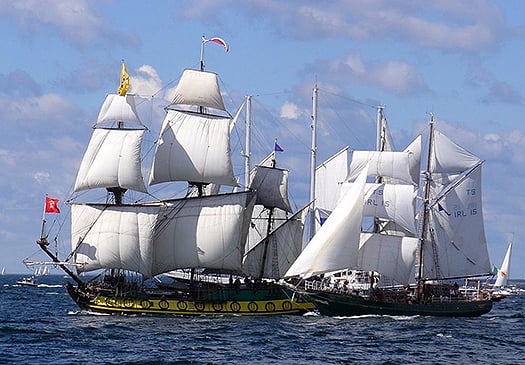
The pain of it. You search out a photo of Shtandart, the remarkable Russian re-creation of an 18th century ship, and you find that Asgard II is sailing beside her
It was while sourcing a photo of Russia's unusual sail training ship Shtandart that the pain of the loss of Asgard II emerged again. It's always there, just below the surface. But it's usually kept in place by the thought that we have to move on, that worse things happened during the grim years of Ireland plunging ever deeper into recession, and that while our beloved ship did indeed sink, no lives were loss and her abandonment was carried out in an exercise of exemplary seamanship.
Yet up came the photo of the Shtandard, and there right beside her was Asgard II, sailing merrily along on what's probably the Baltic, and flying the flag for Ireland with her usual grace and charm. The pain of seeing her doing what she did best really was intense. She is much mourned by everyone who knew her, and particularly those who crewed aboard her. All three of my sons sailed on her as trainees, they all had themselves a great time, and two of them enjoyed it so much they repeated the experience and both became Watch Leaders. It was very gratifying to find afterwards, when you went out into the big wide world and put "Watch Leader Asgard II" on your CV, that it counted for something significant in international seafaring terms.
But as a sailing family with other boat options to fall back on, we didn't feel Asgard II's loss nearly as acutely as those country folk for whom the ship provided the only access to the exciting new world of life on the high seas.

Elaine Byrne vividly recalls how much she appreciated sailing on Asgard II, and how she and her siblings, growing up in the depths of rural Ireland, came to regard the experience of sailing as a trainee on the ship as a "Rite of Passage" through young adulthood
The noted international investigative researcher, academic and journalist Dr Elaine Byrne is from the Carlow/Wicklow border, the oldest of seven children in a farming family where the household income is augmented with a funeral undertaking business attached to a pub in which she still occasionally works. Thus her background is just about as far as it's possible to be from Ireland's limited maritime community. Yet thanks to Asgard II, she was able to take a step into the unknown world of the high seas as a trainee on board, and liked it so much that over the years she spent two months in all aboard Asgard II, graduating through the Watch Leader scheme and sailing in the Tall Ships programmes of races and cruises-in-company
Down in the depths of the country, her new experiences changed the Byrne family's perceptions of seafaring. Elaine Byrne writes:
"Four of my siblings (then) had the opportunity to sail on Asgard II. If it were not for Asgard II, my family would never have had the chance to sail, as we did not live near the sea, nor had the financial resources to do so. The Asgard II played a large role in our family life as it became a Rite of Passage to sail on board her. My two youngest siblings did not sail on the Asgard II because she sank, which they much regret".
She continues: "Apart from the discipline of sailing and the adventure of new experiences and countries, the Asgard brought people of different social class and background together. There are few experiences which can achieve so much during the formative years of young adulthood"
That's it from the heart – and from the heart of the country too, from l'Irlande profonde. So, as the economy starts to pick up again, when you've heard the real meaning of Asgard II expressed so directly then it's time to expect some proper tall ship action for Ireland in the near future. But it's not going to be a simple business. So maybe we should take quick canter through the convoluted story of how Asgard II came into being, in the realization that in its way, creating her successor is proving to be every bit as complex.
As we shall see, the story actually goes back earlier, but we'll begin in 1961 when Erskine Childers's historic 1905-built 51ft ketch Asgard was bought and brought back by the Irish government under some effective public pressure. It was assumed that a vessel of this size – quite a large yacht by the Irish standards of the time – would make an ideal sail training vessel and floating ambassador. It was equally assumed that the Naval Service would be happy to run her. But apart from keen sailing enthusiasts in the Naval Reserve - people like Lt Buddy Thompson and Lt Sean Flood – the Naval Service had enough on its plate with restricted budgets and ageing ships for their primary purpose of fishery patrol.
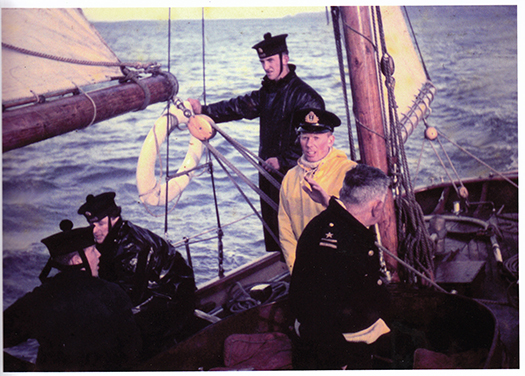
Aboard the first Asgard in 1961 during her brief period in the 1960s as a sail training vessel with the Naval Service – Lt Sean Flood is at the helm
So Asgard was increasingly neglected throughout the 1960s until Charlie Haughey, the new Minister for Finance and the only member of Government with the slightest interest in the sea, was persuaded by the sailing community that Asgard could become a viable sail training ship. In 1968 she was removed from the remit of the Department for Defence into the hands of some rather bewildered officials in the Department for Finance, and a voluntary committee of five experienced sailing people - Coiste an Asgard - was set up to oversee her conversion for sail training use in the boatyard at Malahide, which just happened to be rather less than a million miles from the Minister's constituency.
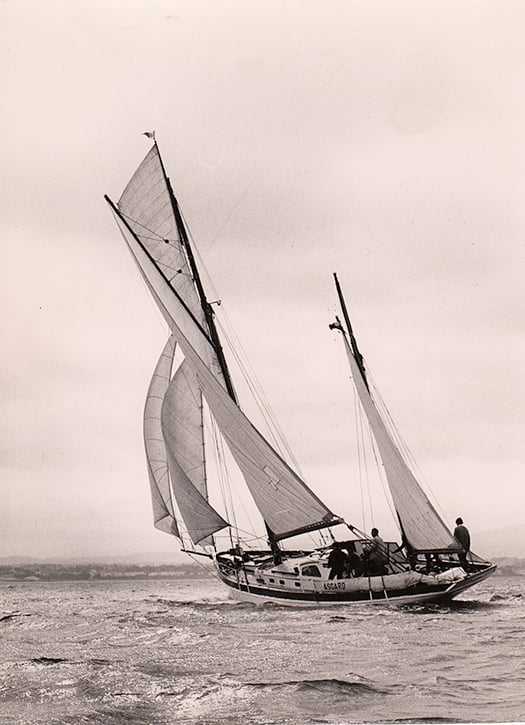
Asgard in her full sail training role in 1970 in Dublin Bay
Asgard was commissioned in her new role in Howth, the scene of her historic gun running in 1914, in the spring of 1969. Under the dedicated command of Captain Eric Healy, the little ship did her very best, but it soon became obvious that her days of active use would be limited by reasons of age, and anyway she was too small to be used for the important sail training vessel roles of providing space to entertain local bigwigs and decision-makers in blazers.
By 1972, the need for a replacement vessel was a matter of growing debate in the sailing community, and during a cruise in West Cork in the summer of 1972, I got talking to Dermot Kennedy of Baltimore out on Cape Clear. Dermot was the man who introduced Glenans to Ireland in 1969, and then he branched out on his own in sail training schools. A man of firm opinions, he reacted with derision to my suggestion that Asgard's replacement should be a modern glassfibre Bermudan ketch, but with enough sails to keep half a dozen trainees busy.
"Nonsense" snorted Dermot. "Ireland needs a real sailing ship, a miniature tall ship maybe, but still a real ship, big enough to carry square rig and have a proper clipper bow and capture the imagination and pride of every Irish person who sets eyes on her. And she should be painted dark green just to show she's the Irish sail training ship, and no doubt about it".
Some time that winter I simply mentioned his suggestions in Afloat magazine, and during the Christmas holidays they were read by Jack Tyrrell at his home in Arklow. During his boyhood, in the school holidays he had sailed with his uncle on the Arklow schooner Lady of Avenel, and it had so shaped his development into the man who was capable of running Ireland's most successful boatyard that he had long dreamed of a modern version of the Lady of Avenel to be Ireland's sail training ship.
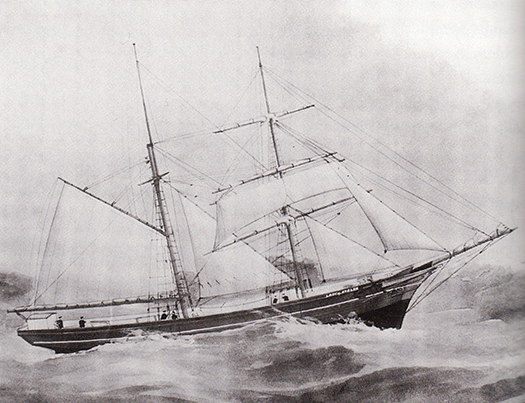
The inspiration – Jack Tyrrell's boyhood experiences aboard Lady of Avenel inspired him to create Ireland's first proper sail training ship
In fact, in 1954 he had sketched out the plans for a 110ft three masted training ship, but Ireland in the 1950s was in the doldrums and the idea got nowhere. Yet the spark was always there, and it was mightily re-kindled by what Dermot Kennedy had said. So at that precise moment, the normal Christmas festivities in the Tyrrell household were over. They'd to continue the celebrations without the head of the family. The great man took himself off down to the little design office in his riverside boatyard, and in clouds of pipe tobacco smoke, he re-drew the lines of the 110ft three master to become an 83ft brigantine, the size reduction meaning that the shop would only need a fulltime crew of five.
Working all hours, he had the proposal drawings finished in time to rejoin his family to see in the New Year. And in the first post after the holiday, we got the drawings at Afloat, and ran them in the February 1973 issue.
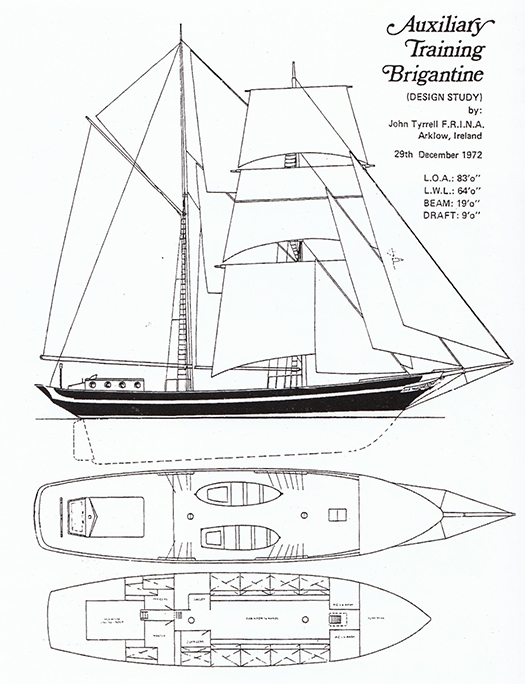
Jack Tyrrell's proposal drawings for the new brigantine, as published in the February 1973 Afloat
In Ireland then as now, most politicians had inscribed in their heads the motto: "There's No Votes In Boats". So after Charlie Haughey had fallen from favour with the Arms Trial of 1970, Coiste an Asgard became an orphan. But 1973 brought a new government, and there was one cabinet minister in it who was proud to proclaim his allegiance to the sea.
Unfortunately for the respectability of the maritime movement in Ireland, our supporters in the higher echelons of politics have often tended to be from the colourful end of the political spectrum, whatever about their placing in the left-right continuum. Thus it was that, at mid-morning on St Patrick's Day 1973, I got an ebullient phone call and an immediate announcement, without the caller saying who he was. "Winkie" he bellowed, "That ship is going to be built. I'll make sure of it. I've just made a ministerial decision".
It emerged that it was our very own new Minister for Defence, Patrick Sarsfield Donegan TD. The enthusiasm for the new ship, engendered by studying Jack Tyrrell's drawings, led to a snap decision which stayed decided, and it all happened in the Department for Defence.
However, it was 1981 by the time the ship was launched, and she looked rather different from Jack Tyrrell's preliminary drawings, though the basic hull shape built in timber was the same sweet lines as originally envisaged, so she was able to sail like a witch. But as for her supporters at Government level, the non-stop cabaret continued. Charlie Haughey had regained power, and by 1981 he was Taoiseach. It was he who had seen to it that the Department of Defence continued to look after the Asgard II project with support from another sailing TD who might not have seen eye–to-eye with him on other matters, Bobby Molloy of Galway.
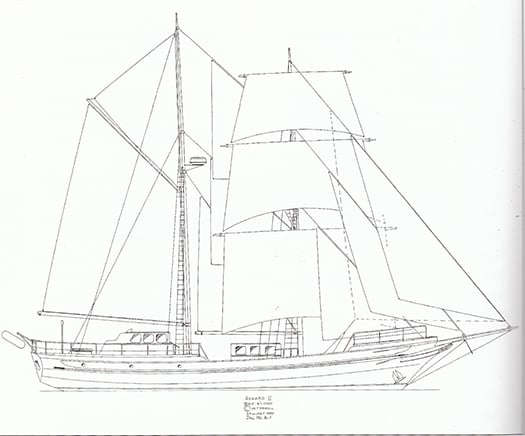
Asgard II in her finished form
So on a March day in 1981, almost exactly twelve years after he'd commissioned the original Asgard in her new role as a sail training vessel, Charlie Haughey took it upon himself to christen the new Asgard II in Arklow basin. And the champagne bottle refused to break. Five or six time he tried, but with no success.
Showing considerable grace under pressure and observed by a large crowd, he quietly took his time undoing all the ribbons and paraphernalia on the big bottle. Then he marched with it up to the new flagship's stem, and hit it a mighty double-handed wallop. The bottle exploded that time, with no mistake. And apart from the usual Haughey growl to those nearby about the idiocy of whoever forgot to score the champagne bottle beforehand, it was all done with the best of humour.
For most of her subsequent career, there's no doubt Asgard was a lucky and very successful vessel. Yet when her demise came, you couldn't help but think of the old notion that if the champagne bottle doesn't break first time, then she'll ultimately be an unlucky ship.
But there are more prosaic explanations. With a limited budget and every penny being scrutinized, Jack Tyrrell and his men had to build Asgard II in fishing boat style, which is fine within its proper time span, but that time span is really only twenty years, maybe thirty if the ship gets extra care. But with her fishing boat hull carrying a demanding brigantine rig, although she always looked immaculate, Asgard II was starting to show her age in the stress areas.
By 2005 there was serious talk about the need to plan for a replacement. When her skipper Colm Newport was told to renew her rig as the original spars were clearly well past it, he meticulously searched the best timber yards at home and abroad and when she got her new rig – it was 2006 or thereabouts – I wrote an only slightly tongue-in-cheek article suggesting that now was the time to replace her old tired wooden hull with a new steel one to the same Jack Tyrrell lines, but utilising the excellent new rig and as many of the fixtures and fittings as were still in good order from the original ship.
To say the response was negative is understating the case. People's attachment to Asgard could only imagine a wooden ship. It was the end of any meaningful debate. So things drifted on, with each new government seemingly even less interested in maritime matters generally, and sail training in particular, than the one before.
In September 2008, Asgard started taking in water while on passage with a crew of trainees towards La Rochelle for a maritime festival following which - while still in La Rochelle – it was planned that she would be lifted out for a thorough three week survey and maintenance programme.

Asgard's accommodation worked superbly whether at sea or in port. But the fact that so much was packed into a relatively small hull meant that some areas were almost inaccessible for proper inspection
It might have been the saving of her. But it was not to be. It's said that it was a failed seacock which caused the catastrophic ingress of water. She was a very crowded little ship, she packed a lot into her 84ft, so some hull fittings were less accessible internally than they would be in a more modern vessel, and may have deteriorated to a dangerous level. But if, as some would propose, she hit something in the water which caused a plank to start, then the fact that nobody aboard was aware of any impact suggests that the time for a major overhaul, and preferably a hull replacement, was long overdue.
The moment Asgard II sank, she ceased to have any future as a sail training vessel, and there was no real official interest in her salvage. You simply cannot take other people's children to sea on a salvaged vessel of doubtful seaworthiness. And as it happens, the sinking came at exactly the time the Irish economy fell of a cliff. So although after an enquiry the Government accepted a €3.8 million insurance settlement, in the end, despite assurances to the contrary, it disappeared into the bottomless pit which was the national debt, and within a year Coiste an Asgard was wound up with its records and few resources incorporated into a new entity, Sail Training Ireland.
The plot takes a further macabre twist in that, shortly after the loss of Asgard II, the Northern Ireland Sailing Training ketch was also lost after hitting a rock on the Antrim coast. From having two popular and well-used sail training vessels in the middle of 2008, within a year Ireland had no official sail training vessels at all.
Yet though the flame had been largely subdued, there were those who have kept the faith, and gradually the sail training movement is being rebuilt. Sail Training Ireland is the frontline representative for around five different organisations, being the official affiliate of Sail Training International, and it has a busy programme of placing trainees in ships which operate at an international level, in which the Dutch are supreme.
In Ireland at the moment, the only sail training "ship" is the schooner Spirit of Oysterhaven, run by Oliver Hart and his team from their adventure centre near Kinsale. In fact, Spirit – you can read about her in Theo Dorgan's evocative book Sailing For Home (Penguin Ireland 2004) – really is punching way above her weight in representing Ireland in a style reminiscent of both the Asgards.
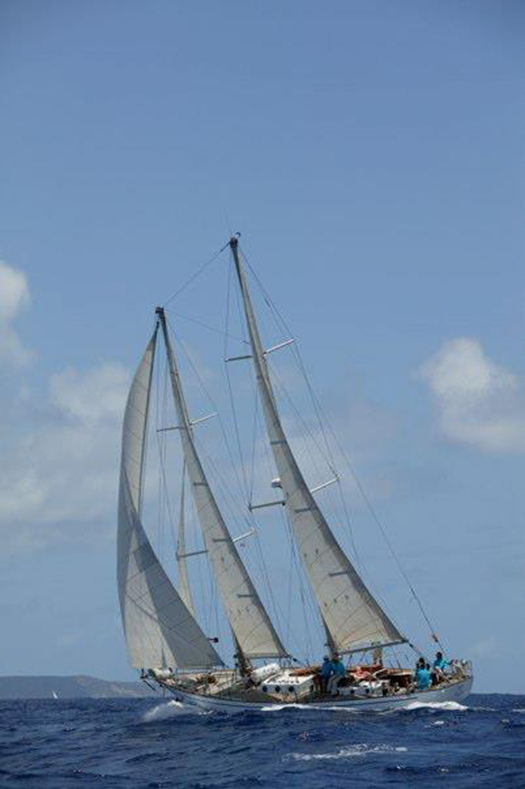
Spirit of Oysterhaven has been doing great work in keeping sail training alive in Ireland
But having the ship is one thing, paying the fees for the trainees to be aboard is something else, and sail training bursaries are one of the key areas of expansion in current maritime development in Ireland. There was an unusual turn to this in 2014 when somebody came up with the bright idea of using Irish Cruising Club funds (which are generated by the surplus from the voluntary production of the club's Sailing Directions) to provide bursaries for youngsters to take part in last summer's ICC 85th Anniversary Cruise-in-Company along the southwestern seaboard on Spirit of Oysterhaven.
The idea worked brilliantly, and this concept of neatly-tailored sail training bursaries is clearly one which can be usefully developed. But still and all, while it's great that young Irish people are being assisted in getting berths aboard charismatic vessels like Europa, the feeling that we should have our own proper sail training ship again is gradually gaining traction, and this is where the Atlantic Youth Trust comes in.
The AYT had its inaugural general meeting in Belfast as recently as the end of September 2014, so it may not yet have come up on your radar. But as it has emerged out of the Pride of Ireland Trust which in turn emerged from the Pride of Galway Trust, you'll have guessed that Enda O'Coineen and John Killeen are much involved, and they've roped in some seriously heavy hitters from both sides of the border, either as Board Members or backers, and sometimes as both.
The cross-border element is central to the concept of building a 40 metre three-masted barquentine, a size which would put her among the glamour girls in Class A, and could carry a decidedly large complement of 40 trainees, even if you're inevitably talking of stratospheric professional crewing costs.
However, by going straight in at top government level on both sides of the border, the AYT team are finding that they're pushing at a door which wants to open, particularly after the new Stormont House agreement was reached in the last days of 2014 to bring a more enthusiastic approach both to cross-community initiatives in the north, and cross border co-operation generally.
Who knows, but if they can succeed in getting cross-community initiatives working in Northern Ireland, then they may even be able to swing some sort of genuine Dublin-Cork shared enthusiasm in the Republic, for I've long thought that one of the factors in holding back many maritime initiatives in Ireland is that, while Dublin may be the political capital, Cork is quietly confident it's the real maritime capital, and does its own thing.
Be that as it may, the AYT have done serious studies, and their conclusion is the best scheme to learn from is the Spirit of Adventure programme in New Zealand. This is where the feeling of going back to the future arises, for in looking at photos of their ship Spirit of New Zealand, there's no escaping the thought that you're looking at Jack Tyrrell's concept ship of 1954 brought superbly to life.
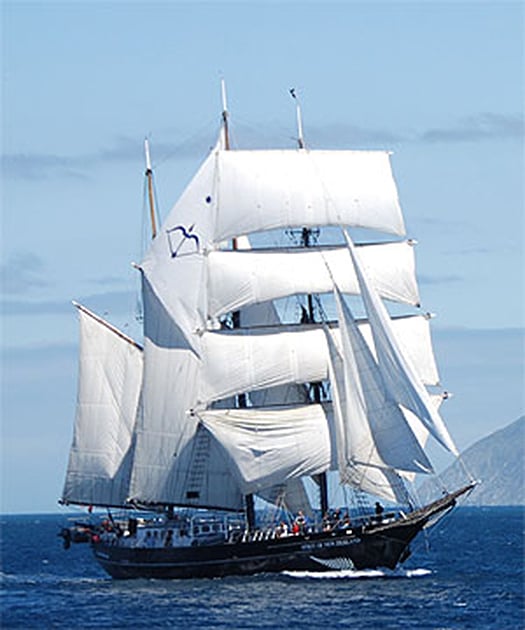
Spirit of New Zealand

Spirit of New Zealand almost seems like a vision of 1954 brought to life...

.....and that vision is Jack Tyrrell's 1954 concept for a 110ft sail training ship
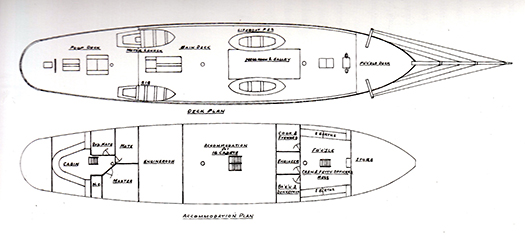
The 1954 accommodation drawings for the 110ft ship hark back to a more rugged age. Imagine the difficulties the ship's cook would face trying to get hot food from his galley on deck amidships all the way back to the officers in their mess down aft
We needn't necessarily agree with all the AYT's basic thinking For instance, they assert that Ireland is like New Zealand is being an isolated smallish island. It depends what you mean by "isolated". Those early sail training pioneers, the Vikings, certainly didn't think of Ireland as isolated. They thought it was central to the entire business of sailing up and down Europe's coastline.
Thus any all-Ireland sail training vessel would be expected to be away abroad at least as much as she'd be at home, whereas Spirit of New Zealand is usually home – the season of 2013-2014 was the first time she'd been to Australia since 1988, when she was in the fleet with Asgard II for the First Feet celebrations.
In New Zealand, she's a sort of floating adventure centre, and a large tender often accompanies her to take the trainees to the nearest landing place for shoreside adventures, for it's quite a challenge keeping 40 energetic young people fully occupied.
In Europe, that's where the sail training races come in. Time was when the racing aspect was down-played. But there's nothing like a good race to bring a mutinous crew together, and the recently-published mega-book about the world's sail training vessels, Tall Ships Today by Nigel Rowe of Sail Training International, quite rightly devotes significant space to everything to do with the racing.
Thus if we do get a new sail training ship for Ireland, she'll have to sail well and fast. That was Asgard II's greatest virtue. For there is nothing more dispiriting for troubled young folk than to find themselves shackled to the woofer of the fleet. Yet you'd be pleasantly surprised by how previously disengaged youngster can become actively and enthusiastically involved when they find that they're being transformed from scared and seasick kids into members of a winning crew.
So now, the 64 thousand dollar question. The cost. It's rather more than 64 thousand. AYT reckon they'll have to come up with a final capital expenditure of €15 million to build the ship and get her into full commission with proper crewing and shoreside administration arrangements in place. But after that – and here's the kernel of the whole concept – they reckon that the running costs will come out of existing government expenditure already in place and used every year for education, youth training, sporting facilities, social development and so forth.
So their pitch is that if the governments north and south come up with funding to support substantial donations already proposed for AYT by various benevolent national and international bodies, then once the ship is in being, she will generate her own income in the same way as vessels like Europa and Morgen Stern are already doing in mainland Europe.
And it's to the heart of mainland Europe that they'll be looking for design and contruction, as it's the Dykstra partnership which will be overseeing the design, and their ship-build associate company Damen will likely do the construction work, though one idea being floated is that Damen might provide a flatpack kit for the vessel to be built in steel in Ireland.
Those of us who dream of Asgard II being built anew will find all this a bit challenging to take on board. My own hopes, for instance, would still be to build Asgard II again to Jack Tyrrell's lines, but with the hull constructed in aluminium. It would be expensive as it would need to be double-skin below the waterline, but the ship's size would be very manageable with a professional crew of just five, while she'd sail like a dream And proper top-class marine grade aluminium seems to last for ever, as naval architect Gerry Dijkstra (his surname is slightly different from that of the partnership) himself shows with his remarkable cruises with his own-designed alloy 54-footer Bestevaer.
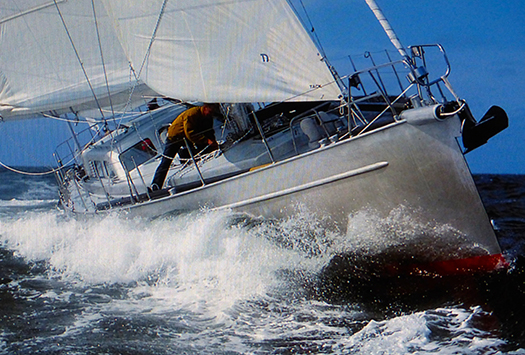
A man who knows what he's doing. This is Gerry Dijkstra's own extensively-cruised alloy-built 54 footer Bestevaer. The name translates not as "Best ever", but either as "best father" or "best seafarer", and was the name of affection given to the great Admiral de Ruyter by his loyal crews
Whatever, the good news is that things are on the move, and we wish them well, all those who have kept the Irish sail training flame alive through some appalling setbacks. Now, it really is the time to move forward. And if we do get a new ship, why not call her the Jack Tyrrell? He, of all people, was the one who kept the faith and the flame alive.
- Tall ship
- Belfast
- Jack Tyrell
- Kristiansand
- Aalesund
- Titanic
- maritime
- Class A
- square riggers
- George Stage
- Alexander Von Humboldt
- Christian Radich
- Sorlandet
- Shtandart
- Brigantine
- Asgard II
- Elaine Byrne
- Erskine Childers
- Sean Flood
- Naval
- Afloat magazine
- boatyard
- sail training ship
- Coiste an Asgard
- Charlie Haughey
- Colm Newport
- Irish Cruising Club
- Spirit of Oysterhaven
- Enda O'Coineen
- John Killeen
- Dykstra
Ireland's Maritime Strategy 'A Model To Follow' For Malta
#Maritime - Is Ireland a model to follow when it comes to maritime strategy?
It is according to Simon Mercieca of the University of Malta, who blogs on the Malta Independent website about the need for his country to take lessons from the Irish experience.
Citing his visit to a maritime history conference at University College Cork late last year, Dr Mercieca is full of praise for Marine Minister Simon Coveney and his department's focus on revitalising Ireland's ports and coastal areas.
That stands in stark contrast to the situation on Malta as Dr Mercieca would have it, describing a country where maritime "is today a non-entity in our political discussion".
"Despite the fact that Malta built its fortune on its geographical position in the middle of the Mediterranean Sea, the country now lacks a serious maritime vision."
The Malta Independent has more on the story HERE.
#Maritime - Ireland has been "sea-blind" for decades and needs a "strong maritime constituency" to make the most of our significant ocean and coastal resources, according to the nation's highest ranking naval officer.
Rear Admiral Mark Mellett DSM was speaking at the launch of a new book celebrating 25 years of RTÉ Radio's Seascapes programme at the National Maritime Museum in Dun Laoghaire last Monday 1 December.
Citing Ireland's mostly maritime jurisdiction - "three times the size of Germany, one million square kilometres, 92% of which is underwater... with trillions of euros of yet-to-be-found hydrocarbon and mineral resources" - he lamented that the nation had taken so long to embrace the sea.
"Over many decades, in my own view, in particular since the foundation of the State, we've been sea-blind. We haven't recognised our maritime heritage to the level that we should," said the Deputy Chief of Staff of the Defence Forces.
"And that's why it's important that institutions like the Maritime Museum of Ireland have stood us in good stead by re-establishing our constituency, and more recently I'm delighted that Government from the centre, through Harnessing Our Ocean Wealth, is driving that maritime constituency."
In particular, Admiral Mellett hailed "initiatives like the Irish Maritime and Energy Resource Cluster... [that] aim to establish at least 3,000 jobs in the maritime sector" in the coming years.
"But good governance needs a strong maritime constituency," he added. "And it needs champions... But more than that, it needs thought leaders, thought leaders like Tom MacSweeney, thought leaders like Lorna Siggins [Irish Times Marine Corr – Ed] and thought leaders like Marcus Connaughton, people who define and set the agenda in the maritime."
WM Nixon has much more on the Sailing By book launch in his latest blog entry HERE.
Seascapes On RTE Radio 1 Has Much To Celebrate After 25 Years
#seascapes – The maritime community in Ireland is a mystery to the vast majority of the rest of the population. Admittedly anyone Irish will sing enthusiastically about how good it is to be entirely surrounded by water. But for most folk among a people who like to think that they're basically rural even if the reality is they're increasingly urban, the sea is seen as no more than a useful barrier, while the coast is only briefly a fun place at the very height of a good summer.
The sea and the coastal interface are not seen as an exciting world in itself, a unique environment which deserves to be explored, enjoyed and utilised in practical and often beneficial ways. On the contrary, the popular view of the plain people of Ireland is that the less they know about the sea, the better. And the unspoken corollary of this is that anyone who seeks to go to sea for recreation is at best a bit odd, maybe even a misfit ashore, while those who work on the sea only do so because they couldn't get a job on land.
Here at Afloat.ie, in its various manifestations over the past 52 years, we've been trying to spread mutual understanding and useful information among the many and varied strands of those who go afloat for sport and recreation in Ireland and beyond. We know this is largely a matter of preaching to the converted. But we also try to do our bit to welcome those who may be newcomers to the world of boats, while remaining keenly aware of the drawbacks of over-selling our sport, our hobby – our obsession, if you wish.
Sailing and boating in Ireland can be rugged enough. Thus the sport in all its forms can only expand in a sustainable way if it attracts people who will themselves bring something positive to the party, for interacting usefully with boats is not a passive affair. And there has been a certain level of success. Over the years, while there was an understandable blip in boating numbers during the recent recession, the graph has been reasonably healthy when it's remembered that rival sport and entertainment attractions are proliferating all the time, while the increasing availability of holidays afloat in sunnier climates makes the promotion of boating activity within Ireland more problematic.
Fifty-two years ago, beginning a process of regular communication among Ireland's recreational boating community was quite a challenge. But it was a very straightforward project compared with inaugurating a regularly weekly broadcast maritime programme for all listeners on national radio in a country notably averse to the sea. Yet it all began 25 years ago, and it's still going strong.
So how do you celebrate 25 years of a niche radio programme, a little Irish maritime magazine of the air? It would be too much to expect a documentary on primetime television. And even an extra-long gala edition on the national radio airwaves at peak listening times might well be counter-productive. So it seems the answer is that the best way to celebrate 25 years of Seascapes on RTE Radio 1 is to publish a book well-filled with some of the key broadcasts with which it has been associated. And as those now-printed broadcasts include a maritime-themed series of the prestigious Thomas Davis Lectures, you mark the anniversary by sending out those as broadcasts again in their own right twelve years after their first transmission.
It may all sound almost devious, a matter of managing to slip the Seascapes celebrations in under the RTE management radar. But those of us who have been banging the maritime development drums for a very long time are well aware that, though the tide is definitely turning, there's still a huge underlying resistance to anything to do with the sea and boats, and it takes an element of cunning to get the message across such that, in time, the people are themselves singing from the same hymn sheet, and thinking it was all their idea in the first place.
But the founder of Seascapes 25 years ago, RTE's Cork reporter Tom MacSweeney, makes your average terrier look like a tired old dog. A sailing and maritime enthusiast himself even though his family had been from a non-maritime background, he had as a child in Cork been inspired by his grandfather's great respect for seafarers, and the vital task they performed in keeping Ireland connected with the rest of the world. He could see the sea all about us, and Cork is the most maritime of cities. So he just kept nagging RTE until they gave him a quarter of an hour once a week back in 1989 to put on a maritime programme for an island nation. And though it has been shifted around in the schedules, it is now a solid half hour every Friday night at 10.30pm, a worthy fulfilment of RTE's public service remit - you really do get a sense of Seascape's nationwide listening community, while podcasts make it more accessible than ever.
The sheer volume of material from all round Ireland's coasts, from our lakes and rivers, and from Irish seafarers abroad, is simply monumental, a treasure trove. So in producing the book (it's published by Liffey Press at €20 with all royalties going to the Lifeboat Service), they'd to wield a fierce scalpel. And though it includes the complete set of Thomas Davis lectures from twelve years ago, it's still of manageable size (in other words, you can read it in bed), while giving a good overview and flavour of the kind of material Seascapes broadcasts, and what we might call the house style.
In Tom MacSweeney's days of producing and presenting it from 1989 until he retired from RTE in January 2010, it has to be agreed that very occasionally the nagging which got Seascapes its slot in the first place sometimes spilled over onto the airwaves in the programme itself. Okay, we all know that Ireland is not as sea-minded as it might be. But things are slowly improving in this, and they might improve more quickly if the maritime movement relied more on the path of gentle encouragement and inspiring example rather than constantly reiterating the tedious refrain of "the government should do this, the government should do that....."
From time to time, I have to confess I thought the worst possible thing was to get the government involved at all, having seen what the official encouragement and enforcement of the Irish language had achieved since the establishment of the state. There'd be occasions when you'd think the best way to turn the Irish into a nation of doughty sailors would be to declare seafaring illegal. The people would have taken to boats in their droves....But nevertheless the tide is slowly but definitely turning, and in today's less frenetic atmosphere of businesslike maritime promotion and development, we're becoming more comfortable in our relationship with the sea.

Man of the sea. Rear Admiral Mark Mellett DSM on exercises with the Naval Service off the Cork coast.
So it was entirely appropriate that, in the launching of the Seascape's compendium Sailing By, the main speaker in both the Cork Harbour Commissioners' building on the Friday night (November 28th), and in the National Maritime Museum in Dun Laoghaire on Monday, was Rear Admiral Mark Mellett DSM, our most distinguished navy man, who has risen to the august heights of Deputy Chief of Staff of the Defence Forces.
If you requested Central Casting to provide an Irish Admiral who conveys the expected air of competence with the necessary gravitas and presence, while still having that essential Irish twinkle, then they'd send you Mark Mellett. We'd most of us heard of his steady rise through the senior ranks, but for many of us in the National Maritime Museum on a damp December night, it was the first experience of seeing Admiral Mellett in a professional and public capacity. For people from a very wide range of interests and activities in the maritime sphere, it was very encouraging – we feel we now have a spokesman who can ably represent us at every level, however formal or high powered, while at the same time retaining the human touch.
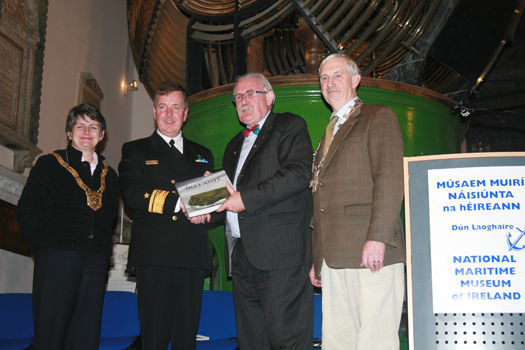
Top people at the launching of the Seascapes book Sailing By are (left to right) Cllr Marie Baker (Cathaoirleach of Dun Laoghaire-Rathdown County Council), Rear Admiral Mark Mellett DSM (Deputy Chief of Staff , Defence Forces), Marcus Connaughton of Seascapes, and Richard McCormick, President of the National Maritime Museum. Admiral Mellett is being presented with the book The Atlantic Coast of Ireland, as he already has his own copy of Sailing By – he wrote the foreword.
His enthusiasm is palpable, and he provided a foreword for the book which speaks from the heart, yet provides a practical and businesslike outlook. In fact, that was the flavour of the evening in the National Maritime Museum, as it was hosted by Richard McCormick, the recently elected President of the National Maritime Museum, and the speakers included the Cathaoirleach of Dun Laoghaire-Rathdown County Council, Cllr. Marie Baker, and Tom McGuire, head of RTE Radio 1, who knows better than anyone just what has been needed to keep Seascapes on the airwaves for 25 years.
Most of all it has of course been the sheer dogged determination of Tom MacSweeney working on his own as producer and presenter in RTE's Cork studio, followed by his successor Marcus Connaughton, who came in as producer when the Thomas Davis Lectures were added to an already almost impossibly demanding schedule in 2002, and stayed on to become presenter eight years later.
They're two very different people. Tom is so involved and enthusiastic that occasionally his own personality, opinions and attitudes cloud the issue. He's a complex man with many interests, not least of them being a national Vice President of the St Vincent de Paul Society. But as regular visitors to Afloat.ie will know, he continues to broadcast his own maritime programmes through community radio, and he's a much-sought-after speaker on sea matters. Recently, he gave a sold-out talk - How Stands Our Island Nation? - to the Dublin Bay Old Gaffers Association in the Poolbeg Y&BC, and while he had the usual serious message, it was leavened by his sharp wit, with the laugh of the evening being provided by his reading of the pained official letter from an Irish Lights Manager complaining about the sheer incompetence and slovenly carelessness of Brendan Behan when he was employed as a painter renovating the St John's Point lighthouse in County Down.
That said, it was a telling lesson in the importance or otherwise of maritime affairs in Ireland's national and cultural life in times past, that the story of a noted playwright making a complete hames of painting a lighthouse was something you knew would register more readily with a general audience than anything of more direct nautical interest, and it is an awareness of the need to reach out gently to the general public which sets the tone of Marcus Connaughton's presentation of Seascapes.
He arrived in the job first as producer, and then as producer/presenter, with no personal baggage in maritime matters. His background was in music production and public relations, and a couple of years ago he brought seventeen years of research and writing to a successful conclusion with the defining biography of Rory Gallagher. But gradually he has become absorbed in and intrigued by the world of boats and the sea. As one of the speakers on Monday night put it, one of the most quietly impressive peformances you'll see is Marcus – who is by no means a small man – sidling into the crowd at some maritime gathering, armed with microphone and recorder, ready and willing to give a voice to the voiceless.
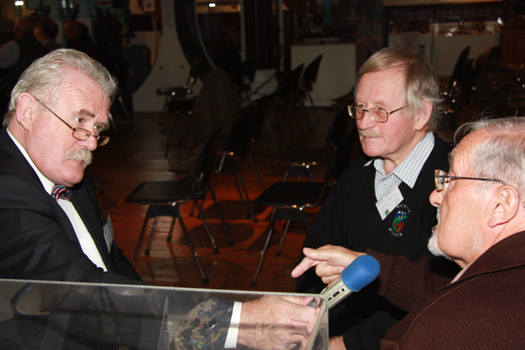
Man at work – Marcus Connaughton records the memories of Alan Martin and Jimmy Carthy of the Dublin Dockworkers Preservation Society
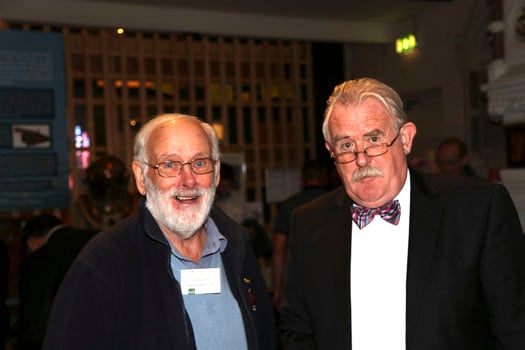
Tim Magennis (left) President of the Dublin Bay Old Gaffers Association, with Marcus Connaughton. Once upon a time, they were work colleagues in the PR Department of Bord Failte

The book launch begins to become a party – Con Murphy of the National YC (left) and Brian Craig of the Royal St George YC getting their copies of Sailing By signed by Marcus Connaughton in the National Maritime Museum. Photo: W M Nixon
The changeover to a new presenter was fairly gradual, but very marked in one thing – he changed the signature tune. When Seascapes started in 1989, they simply borrowed the music which precedes the BBC Shipping Forecast, Ronald Binge's "Sailing By".
"Sailing By" in almost any form is the sound of syrup being poured over sugar lumps, but some folk loved it, so the change to the brisk tone of Simon Mayer's The Reel Thing wasn't universally popular, even if welcomed by those of us trying to cut down on the sucrose.
Yet it's surely an appropriate 25th anniversary sweetener that the published compendium of Seascapes stories is titled Sailing By, and the cover is a fine photo of the renowned pilot cutter Jolie Brise sailing by the Fastnet Rock. It was taken by Brian Carlin of Tralee, who subsequently went on to be the award-winning photographer aboard the Volvo 65 Team Vestas, which unfortunately managed to do some excessive impactive navigation off Mauritius during the Volvo World race last weekend. It was certainly not the photographer's fault, but it heightened the sense of an Irish maritime community worldwide that at Monday night's gathering, Marcus was able to tell us that not only was Brian all right, but that in contacting his father to say so, he requested that the message be passed on to Seascapes as soon as possible.
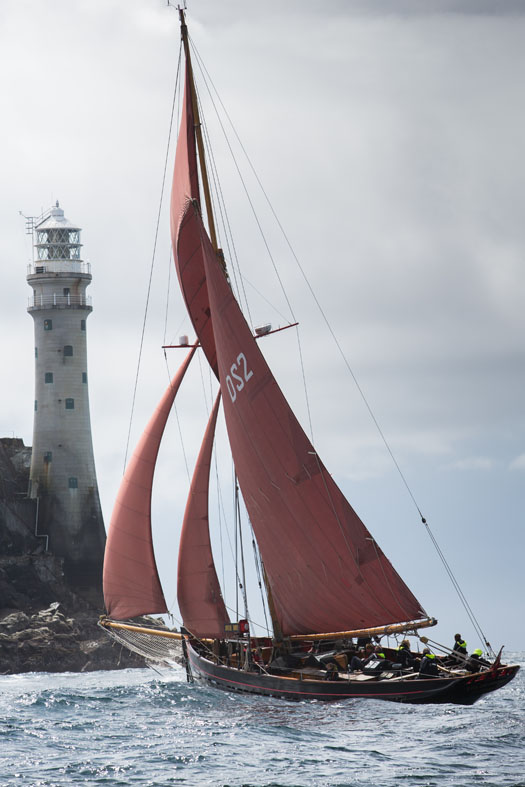
One of award-winning photographer Brian Carlin's studies of Jolie Brise sailing by the Fastnet Rock. Photo: Brian Carlin
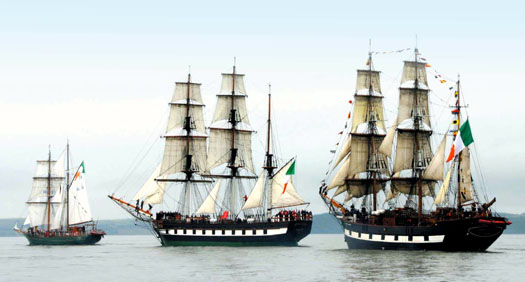
The top moment – it's 2005, and the Seascapes team are on board Asgard II as she leads the Dunbrody of New Ross, and the Jeanie Johnston of Tralee, in the Parade of Sail at the Tall Ships visit to Waterford. Photo: Dave Osborne
As for Marcus's own special recollections of his years with Seascapes, we allowed him six and he ranked them: (1) Being on Asgard II in Waterford with the Tall Ships in 2005, (2) at sea off Hook Head with Martin Colfer amidst enormous schools of lively dolphins, (3) in Galway during both Volvo visits, (4) being far up his beloved Munster Blackwater beyond Ballinatray at the top of the tide, (5) celebrating 25 years of the Killybegs Fishermen's Association at a monster party in the great Donegal port, and (6) being in the renovated National Maritime Museum in Dun Laoghaire when it was re-opened by President Michael D Higgins.
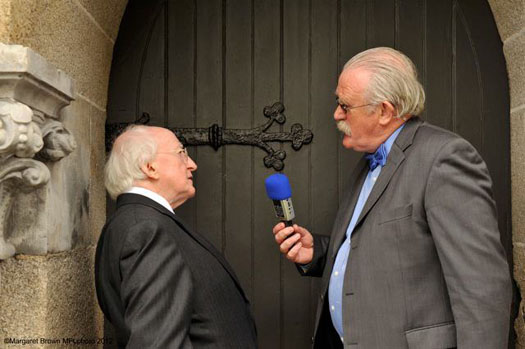
Presidential thoughts of the sea and seafaring in Ireland – Seascapes interviews President Higgins after he has re-opened the restored National Maritime Museum in Dun Laoghaire. Photo: Margaret Brown
Seascapes was of course broadcast as usual last night at 10.30pm, and Marcus Connaughton will be signing copies of Sailing By in Waterstones in Cork this afternoon from 2.0pm to 5.0pm. The first of the six Thomas Davis lectures from 20012 – Paddy Barry's lyrical account of sailing round Ireland – will be broadcast on Friday December 19th, and they'll continue weekly until the final one on February 6th, which is my own item about why most people in Ireland think sailing enthusiasts are so odd. As mentioned at the Glandore Summer School in July, I've changed my mind about some aspects of that, and I'll probably have changed it yet again when Marcus provides me with the space for further thoughts on the matter on Seascapes some time after February 6th.
But meanwhile, happy birthday to Seascapes – you provide a wonderful example of genuine public service broadcasting.
Government Ignores Its Own Islands & Maritime Reports
#islands – On Thursday, October 9, not enough TDs turned up in the Dáil to create a quorum for the business of our national Parliament. The Opposition accused the Government parties of being responsible and of showing lack of commitment to the affairs of the nation.
One of the affairs of the nation to which the Dáil shows lack of interest is the maritime sphere.
The Government is particularly culpable in this regard and is ignoring two reports which it commissioned on the maritime sphere and coastal communities.
I wrote last week about this neglect, questioning in particular the Government's dilution of maritime affairs by moving them into several departments.
This attitude is underlined by the manner in which it has refused to give time to discuss the Oireachtas Committee report on coastal and island communities which was presented to them in January of this year and the CEDRA Report which also made recommendations about maritime affairs.
The Oireachtas Committee which examined and reported on the Islands and Coastal Communities made a request for a national conference to be held by Departments with responsibilities in the maritime sphere. It also called for a debate in the Dáil and Senate on the issues it had highlighted of neglect and failures to support these communities. The Committee highlighted, amongst other issues, that State 'governance arrangements' were "not the best working model."
The Government has not given debate time nor have any of the Departments with involvement in the marine sphere done anything to organise a national conference involving those in the marine sphere to debate the issues. There were more than 30 recommendations in the report, ranging from maritime tourism to the seaweed industry.
Since the report was delivered the State company, Arramara, was sold off by Udaras na Gaeltachta. Questions have been raised about this, the sale has been subject to a lot of criticism, but there has been no Dáil or Senate debate on why another maritime resource, the property of the people of the nation, was sold to private interests. This was done despite the objections of seaweed growers who have alleged that their livelihoods were being destroyed.
Another maritime report by a Commission set up by the Government, which has been ignored since it was delivered, is the CEDRA Report (Commission for Economic Development of Rural Areas) which concluded that there should be 'plan-led' development of Ireland's marine territory to support economic targets and goals set out in the Government's Ocean Wealth Plan. It challenged the Government's commitment to this plan and whether it will, as a result, be effective.
The Chairman of CEDRA, former Kerry footballer and analyst Pat Spillane, did not know that the State company, Arramara, was being sold off by Udaras na Gaeltachta when his Commission recommended that the Government must set up "a regulatory development framework for the State's seaweed sector, both wild and cultivated," which would have economic and employment prospects for national benefit.
Neither did the Chairman of the Oireachtas Fisheries Committee, Andrew Doyle, T.D., know about the Government's agreement to sell off this State company and national resource, when his Committee made a similar recommendation to that of CEDRA's.
Both of these recommendations by State-appointed review bodies, were ignored by the Government. Is this not a clear indication of disregard for the maritime sector?
There are a lot of unanswered questions about how and why this sale was carried out and the effects it will have on the seaweed industry, such as why employment and potential economic benefits were ignored, as were those for whom it provided a livelihood.
Why has this sale not been made an issue for debate in the Dáil? Where are TDs and the national media in challenging aspects of it and asking for explanations?
The public reaction of the CEDRA Chairman to the Government's lack of response to his Commission's Report, which also made recommendations, as did the Oireachtas Committee, about the development of marine tourism and marinas, suggests that the Government's real commitment, away from the public relations spin, may be lacking.
In contrast to the frustration of lack of sufficient p Government focus and commitment to the maritime sector, there is the determination of people like Caitlin Ni Aodha from Helvick in County Waterford. In January of 2012 Caitlin stood on the quayside at Union Hall in West Cork when the Tit Bonhomme trawler tragedy occurred and her husband, Michael, and members of the crew died.

Caitlin Ni Aodha from Helvick in County Waterford
In the latest edition of my fortnightly half-hour radio programme, THIS ISLAND NATION, which you can hear here, I talk on the quayside at Howth to Caitlin as her new boat is launched, a 23-metre prawn freezer. She says that over the last few years she had learned a lot about life, about how good things happened, tragedies occurred, but life had to go on and it was important to do the best one can in life:
"People suffer tragedies, everything is not always easy. Michael and the Tit Bonhomme will be with me for ever. Every day I think of them, but I must do the very best I can with my life."
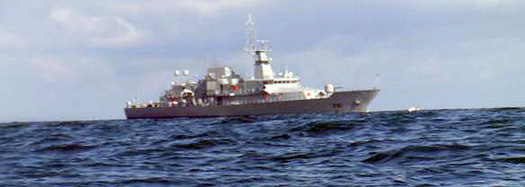
L.E.Samuel Beckett
It is not possible to maximise opportunities from the sea without a strong maritime culture. The Government and its officials could follow that approach to improve their attitude towards the fishing and marine industries. They could also listen to and benefit from hearing the determination of the man in charge of the State's newest naval vessel, Lt.Cdr.Tony Geraghty of the L.E.Samuel Beckett, on the programme. He outlines his determination to demonstrate the public the value of investment in the maritime sphere through the new ship. The ship is a positive State commitment, but the Government generally needs to do much more to show it appreciates that is responsible for the entire welfare of an island nation and to cherish all of its people equally.
Until next week, the usual wish of ..... "fair sailing" ........
Twitter: @AfloatMagazine @Tom MacSweeney



























